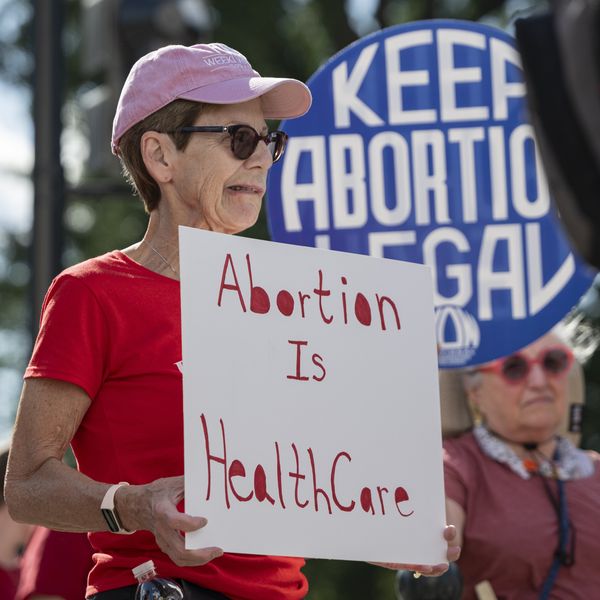
The study concludes that increasing the number of Medicaid beneficiaries in low-income and rural areas is integral to reducing women's and state costs -- as is ensuring that abortion follow-up appointments are reimbursed at those clinics, just as abortions are. (Photo: Bill Clark/Getty Images)
The Problem With Shutting Down Abortion Clinics In Rural And Low-Income Areas
Forcing women to travel long distances to access abortions is bad for both the woman and the state
More and more abortion clinics in the U.S. are shutting down, particularly in rural and underserved areas. A new study shows what happens when women have to travel long distances to access the procedure, and how they are more likely to go to their local emergency department (ED) for any follow-up care -- thus costing them, and the state, way more money.
The study, "Distance Traveled for an Abortion and Source of Care After Abortion," published in the Journal of Obstetrics and Gynecology's September issue, explains why women are more likely to seek out their local ED rather than go back to their abortion provider after they've had the procedure, and illustrates the financial implications of that decision.
In the state of California, where the study was conducted, the authors found that 12 percent of women are forced to travel more than 50 miles to have their procedures, and 4 percent of women travel more than 100 miles. For those women, seeking care after the procedure can be problematic.
"Like with many medical procedures, some women want subsequent care after abortion -- either routine follow-up to confirm the abortion is complete or because they are concerned about symptoms," the study's authors wrote. For many of those affected women, "traveling back to the abortion provider may be too burdensome," leaving those women to seek out their local EDs for follow-up appointments.
According to the study, total costs of post-abortion services at the original abortion provider is, on average, much cheaper than it is at a hospital.
Follow-up services at the same clinic where a woman had the abortion costs an average of $536, whereas post-abortion care in local EDs costs an average of $961. Women who traveled more than 100 miles for their abortion are two times more likely to get follow-up care at their local ED than their original abortion provider.
The study serves as an important reminder that even in a blue state that generally appears to be pro-abortion rights, there are still many barriers when it comes to actually accessing the procedure.
In California, Medicaid covers abortion services, but there are a few caveats, as the study points out -- the Medicaid beneficiaries are so spread out that rural and low-income women can often only afford to make one trip and end up leaning on their local ED for abortion-related follow-up appointments, and Medicaid only covers the cost of the procedure, not those follow-ups.
"For some women, particularly low-income women, it's just too burdensome because it means taking time off from work, arranging for child care, and planning for transportation for another 100+ mile trip," one of the study's authors, Ushma Upadhyay, told HuffPost. "Increasing the number of abortion providers in rural areas, especially in states where there is only one abortion provider, could help reduce the number of ED visits, thereby reducing state costs, and increase continuity of care."
And while the study's research was based in California, Upadhyay, a researcher at the University of California San Francisco, told HuffPost that there are clear nationwide implications to shuttering clinics.
"The relationship between having to travel long distances for abortion care and visiting emergency departments would apply to other populations, regardless of the state or the payer," she told HuffPost. It could certainly be the case in states that only have one abortion clinic left, like Kentucky and Mississippi, or states like Texas, where the remaining clinics are so spread out that women often travel to neighboring states for the procedure.
The study concludes that increasing the number of Medicaid beneficiaries in low-income and rural areas is integral to reducing women's and state costs -- as is ensuring that abortion follow-up appointments are reimbursed at those clinics, just as abortions are.
Check out the entire study here.
An Urgent Message From Our Co-Founder
Dear Common Dreams reader, The U.S. is on a fast track to authoritarianism like nothing I've ever seen. Meanwhile, corporate news outlets are utterly capitulating to Trump, twisting their coverage to avoid drawing his ire while lining up to stuff cash in his pockets. That's why I believe that Common Dreams is doing the best and most consequential reporting that we've ever done. Our small but mighty team is a progressive reporting powerhouse, covering the news every day that the corporate media never will. Our mission has always been simple: To inform. To inspire. And to ignite change for the common good. Now here's the key piece that I want all our readers to understand: None of this would be possible without your financial support. That's not just some fundraising cliche. It's the absolute and literal truth. We don't accept corporate advertising and never will. We don't have a paywall because we don't think people should be blocked from critical news based on their ability to pay. Everything we do is funded by the donations of readers like you. Will you donate now to help power the nonprofit, independent reporting of Common Dreams? Thank you for being a vital member of our community. Together, we can keep independent journalism alive when it’s needed most. - Craig Brown, Co-founder |
More and more abortion clinics in the U.S. are shutting down, particularly in rural and underserved areas. A new study shows what happens when women have to travel long distances to access the procedure, and how they are more likely to go to their local emergency department (ED) for any follow-up care -- thus costing them, and the state, way more money.
The study, "Distance Traveled for an Abortion and Source of Care After Abortion," published in the Journal of Obstetrics and Gynecology's September issue, explains why women are more likely to seek out their local ED rather than go back to their abortion provider after they've had the procedure, and illustrates the financial implications of that decision.
In the state of California, where the study was conducted, the authors found that 12 percent of women are forced to travel more than 50 miles to have their procedures, and 4 percent of women travel more than 100 miles. For those women, seeking care after the procedure can be problematic.
"Like with many medical procedures, some women want subsequent care after abortion -- either routine follow-up to confirm the abortion is complete or because they are concerned about symptoms," the study's authors wrote. For many of those affected women, "traveling back to the abortion provider may be too burdensome," leaving those women to seek out their local EDs for follow-up appointments.
According to the study, total costs of post-abortion services at the original abortion provider is, on average, much cheaper than it is at a hospital.
Follow-up services at the same clinic where a woman had the abortion costs an average of $536, whereas post-abortion care in local EDs costs an average of $961. Women who traveled more than 100 miles for their abortion are two times more likely to get follow-up care at their local ED than their original abortion provider.
The study serves as an important reminder that even in a blue state that generally appears to be pro-abortion rights, there are still many barriers when it comes to actually accessing the procedure.
In California, Medicaid covers abortion services, but there are a few caveats, as the study points out -- the Medicaid beneficiaries are so spread out that rural and low-income women can often only afford to make one trip and end up leaning on their local ED for abortion-related follow-up appointments, and Medicaid only covers the cost of the procedure, not those follow-ups.
"For some women, particularly low-income women, it's just too burdensome because it means taking time off from work, arranging for child care, and planning for transportation for another 100+ mile trip," one of the study's authors, Ushma Upadhyay, told HuffPost. "Increasing the number of abortion providers in rural areas, especially in states where there is only one abortion provider, could help reduce the number of ED visits, thereby reducing state costs, and increase continuity of care."
And while the study's research was based in California, Upadhyay, a researcher at the University of California San Francisco, told HuffPost that there are clear nationwide implications to shuttering clinics.
"The relationship between having to travel long distances for abortion care and visiting emergency departments would apply to other populations, regardless of the state or the payer," she told HuffPost. It could certainly be the case in states that only have one abortion clinic left, like Kentucky and Mississippi, or states like Texas, where the remaining clinics are so spread out that women often travel to neighboring states for the procedure.
The study concludes that increasing the number of Medicaid beneficiaries in low-income and rural areas is integral to reducing women's and state costs -- as is ensuring that abortion follow-up appointments are reimbursed at those clinics, just as abortions are.
Check out the entire study here.
More and more abortion clinics in the U.S. are shutting down, particularly in rural and underserved areas. A new study shows what happens when women have to travel long distances to access the procedure, and how they are more likely to go to their local emergency department (ED) for any follow-up care -- thus costing them, and the state, way more money.
The study, "Distance Traveled for an Abortion and Source of Care After Abortion," published in the Journal of Obstetrics and Gynecology's September issue, explains why women are more likely to seek out their local ED rather than go back to their abortion provider after they've had the procedure, and illustrates the financial implications of that decision.
In the state of California, where the study was conducted, the authors found that 12 percent of women are forced to travel more than 50 miles to have their procedures, and 4 percent of women travel more than 100 miles. For those women, seeking care after the procedure can be problematic.
"Like with many medical procedures, some women want subsequent care after abortion -- either routine follow-up to confirm the abortion is complete or because they are concerned about symptoms," the study's authors wrote. For many of those affected women, "traveling back to the abortion provider may be too burdensome," leaving those women to seek out their local EDs for follow-up appointments.
According to the study, total costs of post-abortion services at the original abortion provider is, on average, much cheaper than it is at a hospital.
Follow-up services at the same clinic where a woman had the abortion costs an average of $536, whereas post-abortion care in local EDs costs an average of $961. Women who traveled more than 100 miles for their abortion are two times more likely to get follow-up care at their local ED than their original abortion provider.
The study serves as an important reminder that even in a blue state that generally appears to be pro-abortion rights, there are still many barriers when it comes to actually accessing the procedure.
In California, Medicaid covers abortion services, but there are a few caveats, as the study points out -- the Medicaid beneficiaries are so spread out that rural and low-income women can often only afford to make one trip and end up leaning on their local ED for abortion-related follow-up appointments, and Medicaid only covers the cost of the procedure, not those follow-ups.
"For some women, particularly low-income women, it's just too burdensome because it means taking time off from work, arranging for child care, and planning for transportation for another 100+ mile trip," one of the study's authors, Ushma Upadhyay, told HuffPost. "Increasing the number of abortion providers in rural areas, especially in states where there is only one abortion provider, could help reduce the number of ED visits, thereby reducing state costs, and increase continuity of care."
And while the study's research was based in California, Upadhyay, a researcher at the University of California San Francisco, told HuffPost that there are clear nationwide implications to shuttering clinics.
"The relationship between having to travel long distances for abortion care and visiting emergency departments would apply to other populations, regardless of the state or the payer," she told HuffPost. It could certainly be the case in states that only have one abortion clinic left, like Kentucky and Mississippi, or states like Texas, where the remaining clinics are so spread out that women often travel to neighboring states for the procedure.
The study concludes that increasing the number of Medicaid beneficiaries in low-income and rural areas is integral to reducing women's and state costs -- as is ensuring that abortion follow-up appointments are reimbursed at those clinics, just as abortions are.
Check out the entire study here.

